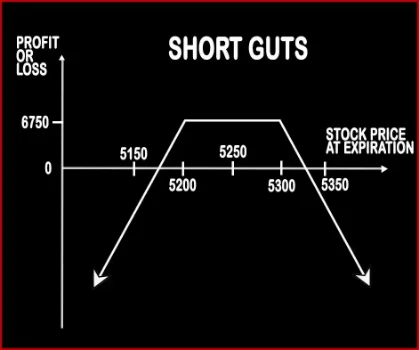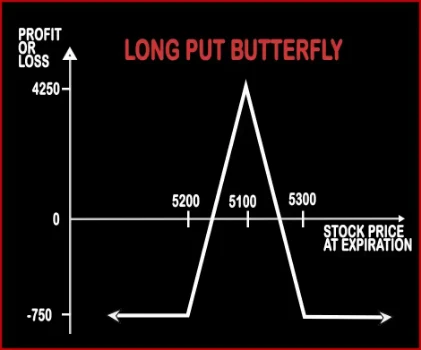Compare Strategies
| SHORT GUTS | LONG PUT BUTTERFLY | |
|---|---|---|

|

|
|
| About Strategy |
Short Guts Option StrategyThis strategy is implemented by a trader when he is neutral on the movements and bearish on volatility i.e. he expects the stock to be range bound in the near future. This strategy involves sale of 1 ITM Call Option and 1 ITM Put Option. This strategy can be called as Credit Spread since his account is credited at the time of entering in the positions. |
Long Put Butterfly Option StrategyThe Long Put Butterfly is a neutral strategy where a trader will be bearish on the volatility i.e. he thinks the market will have sideways kind of movement and will not rally sharply in either direction in the near future. This strategy involves sale of 2 ATM Put Options, buy 1 ITM and 1 OTM Put Option. The risk and reward are limited. |
SHORT GUTS Vs LONG PUT BUTTERFLY - Details
| SHORT GUTS | LONG PUT BUTTERFLY | |
|---|---|---|
| Market View | Neutral | Neutral |
| Type (CE/PE) | CE (Call Option) + PE (Put Option) | PE (Put Option) |
| Number Of Positions | 2 | 4 |
| Strategy Level | Beginners | Advance |
| Reward Profile | Limited | Limited |
| Risk Profile | Unlimited | Limited |
| Breakeven Point | Upper Breakeven Point = Net Premium Received + Strike Price of Short Call, Lower Breakeven Point = Strike Price of Short Put - Net Premium Received | Upper Breakeven Point = Strike Price of Highest Strike Long Put - Net Premium Paid, Lower Breakeven Point = Strike Price of Lowest Strike Long Put + Net Premium Paid |
SHORT GUTS Vs LONG PUT BUTTERFLY - When & How to use ?
| SHORT GUTS | LONG PUT BUTTERFLY | |
|---|---|---|
| Market View | Neutral | Neutral |
| When to use? | This strategy is implemented by a trader when he is neutral on the movements and bearish on volatility i.e. he expects the stock to be range bound in the near future. | The Long Put Butterfly is a neutral strategy where a trader will be bearish on the volatility i.e. he thinks the market will have sideways kind of movement and will not rally sharply in either direction in the near future. |
| Action | Sell 1 ITM Call, Sell 1 ITM Put | Buy 1 OTM Put, Sell 2 ATM Puts, Buy 1 ITM Put |
| Breakeven Point | Upper Breakeven Point = Net Premium Received + Strike Price of Short Call, Lower Breakeven Point = Strike Price of Short Put - Net Premium Received | Upper Breakeven Point = Strike Price of Highest Strike Long Put - Net Premium Paid, Lower Breakeven Point = Strike Price of Lowest Strike Long Put + Net Premium Paid |
SHORT GUTS Vs LONG PUT BUTTERFLY - Risk & Reward
| SHORT GUTS | LONG PUT BUTTERFLY | |
|---|---|---|
| Maximum Profit Scenario | Net Premium Received + Strike Price of Short Put - Strike Price of Short Call - Commissions Paid | Strike Price of Higher Strike Long Put - Strike Price of Short Put - Net Premium Paid - Commissions Paid |
| Maximum Loss Scenario | Price of Underlying - Strike Price of Short Call - Net Premium Received OR Strike Price of Short Put - Price of Underlying - Net Premium Received + Commissions Paid | When Price of Underlying <= Strike Price of Lower Strike Long Put OR Price of Underlying >= Strike Price of Higher Strike Long Put |
| Risk | Unlimited | Limited |
| Reward | Limited | Limited |
SHORT GUTS Vs LONG PUT BUTTERFLY - Strategy Pros & Cons
| SHORT GUTS | LONG PUT BUTTERFLY | |
|---|---|---|
| Similar Strategies | Short Strangle (Sell Strangle), Short Straddle (Sell Straddle) | Iron Condors, Iron Butterfly |
| Disadvantage | • Unlimited potential loss if the underlying stock continues to move in one direction. • High margin required. | • Risk is higher than reward. • When the underlying price is in between the two breakeven points, time decay hurts the position. |
| Advantages | • Ability to profit even when underlying asset stays stagnant. • You are already paid your full profit the moment the position is put on as this is a credit spread position. • Higher chance of ending in full profit as compared to short strangle or short straddle. | • Limited maximum loss. • Unlimited profit potential, risk only limited to loss of premium. • Benefits from low volatility. |